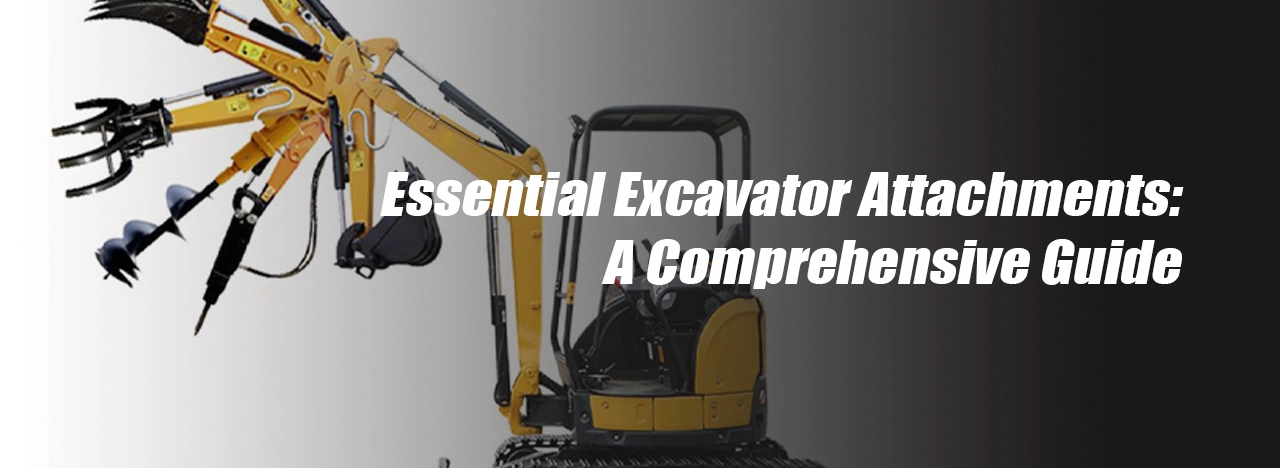Selecting the most suitable excavator attachments is not just a choice; it’s an investment in operational efficiency and project success. With our selection of excavators for sale, you can find the perfect match for your needs, ensuring that your investment pays off. In this comprehensive guide, we delve into the intricate world of excavator attachments, shedding light on the pivotal role they play in construction and excavation projects. Our aim is to empower consumers with the knowledge needed to make well-informed decisions, aligning attachments with tasks, and ultimately enhancing their overall excavator experience.”
Understanding Excavator Attachments
Excavator attachments are key to boosting an excavator’s ability, covering everything from digging and demolition to recycling and landscaping. Picking the right one is crucial for getting the most out of your excavator, making your work more efficient and cost-effective.
These attachments come in various shapes and sizes, each designed for specific jobs. You’ve got your common ones like buckets and breakers, but there’s a whole range of specialized attachments out there for different needs. In our exploration of these attachments, we’ll guide you through the choices, helping you find the perfect fit for your next project.
Importance of Choosing the Right Attachments
Enhanced Operational Efficiency
In the realm of construction, time is money. The right excavator attachment can significantly expedite tasks, reducing project timelines and enhancing overall efficiency. Whether it’s a high-capacity bucket for bulk material handling or a precision auger for hole drilling, the correct attachment streamlines operations.
Maximizing Excavator Potential
Excavators are versatile machines, and their potential is further amplified with the right attachments. A hydraulic thumb, for example, transforms your excavator into a nimble material handler, allowing for precise placement of heavy objects. Understanding and harnessing this potential translates to a more adaptable and productive machine.
Cost-effective Operation
Beyond initial costs, the right attachment choice can influence the long-term operational expenses of your excavator. An attachment that aligns with the project’s demands reduces energy consumption, minimizes wear and tear, and lowers maintenance costs. This strategic approach ensures a cost-effective and sustainable operation throughout the machine’s lifecycle.
Common Types of Excavator Attachments
Bucket
Digging buckets
Digging buckets are ideal for clearing away rocky, compacted environments. They often have teeth around the rim to help the bucket break ground.
Grading buckets
These buckets are wider than most options and feature smooth, rounded edges to assist in leveling operations. They work well as a follow-up to digging, trenching and other buckets that break ground and adjust the foundation of your project.
Rock buckets
Rock buckets are suited to some of the most abrasive, heavy-duty operations, like moving rocks. They may have reinforced parts and strong teeth.
Trenching buckets
Trenching buckets are similar to digging buckets, as they’re also designed to dig. They are usually thinner, though, so they can dig in smaller areas without disturbing any rocks, pipes and other things that may be nearby.
Riddle buckets
Riddle buckets are also called skeletons or shakers. Their main identifying feature is the holes in the bottom that allow you to separate dirt, rock and debris.
V-buckets
Like a trenching bucket, V-buckets or trapezoidal drainage buckets are built for digging trenches. Digging a trench in this shape can prevent its sides from caving in unexpectedly.
Angle tilt buckets
If your operations require a lot of machine movement, consider an angle tilt bucket. These buckets can move independently of your excavator, saving you the time and effort of reorienting the entire machine.
Thumb
As a supplementary component to various excavator attachments, thumbs play a crucial role in securing materials. They exert a clamping force, enhancing material containment within attachments like buckets. Positioned above the bucket’s upper opening, the thumb, when closed, makes contact with the contents inside, effectively gripping and stabilizing them.
This augmentation extends the excavator’s material handling capabilities, requiring auxiliary power for optimal functionality.
Hammer
When dealing with exceptionally tough surfaces like concrete or frost-hardened earth, even the most robust buckets can struggle, risking damage to excavator components. This is where a hydraulic hammer, also known as a breaker, becomes invaluable. Hammers deliver high-impact performance, making them ideal for breaking up challenging materials.
Hydraulic hammers come with various heavy demolition tool bits, including the moil, chisel, and blunt. The moil, featuring a pointed tip, is the standard tool used for trenching and demolition. The chisel serves dual purposes, being effective in both demolition and concrete excavation. The blunt tool is designed for crushing operations, pulverizing large rocks, and breaking down concrete slabs.
To optimize the effectiveness of the hammer attachment, proper sizing is crucial. Small hydraulic breakers suit light-duty projects like concrete work. Medium-sized breakers handle concrete and rock, but consideration of the size and material being broken is essential. Large hydraulic breakers are reserved for substantial projects involving rock and extensive concrete demolition, efficiently managing more challenging materials.
Auger
Augers, equipped with sharp and efficient spiral blades, penetrate deep into the ground, effortlessly breaking through soil, clay, and other materials. Commonly used in construction projects, they are employed to create holes for fence posts. The tips of augers, often referred to as bits, can be constructed from various materials based on the type of ground they will dig through. The two most common auger bits are:
Standard Bit
Ideal for occasional hole drilling in various types of earth, standard bits are versatile tools suitable for excavating teams new to drilling.
Industrial Bit
For heavy-duty tasks that surpass the capabilities of standard bits, industrial bits are a perfect choice. Resistant to breakage and wear, these bits have an extended lifespan.
Ripper
Rippers commonly collaborate with hammers in construction operations. While hammers boast a flat head, rippers feature robust teeth designed to break up materials more effectively, particularly aiding in demolition tasks.
Rippers prove particularly valuable during colder months, as they can penetrate frozen ground, uncovering workable land.
Shears
Shears are specialized attachments engineered for precision cutting through metal materials such as steel beams, pipes, and reinforcement bars. They utilize hydraulic jaws that apply intense pressure, effectively causing the metal to fracture or break apart.
This makes them ideal for projects involving the demolition of steel-framed structures or the recycling of scrap metal.
Grapple
Grapples serve a versatile range of functions, from clamping to efficient material handling. Their applications span various tasks, including land and rock clearing, scrap handling, and the loading of bulky, irregular materials like demolition debris. Widely used in the logging industry, some grapples excel at carrying substantial amounts of tree logs simultaneously. The grapple’s distinctive design facilitates a significant tooth overlap, effectively compressing loads and leaving smaller rocks and dirt behind.
There are two primary types of grapples: the contractor’s grapple and the demolition grapple. The contractor’s grapple features a stationary jaw with an upper jaw that moves off the bucket cylinder. This grapple demands less maintenance and proves excellent for sorting and reprocessing work. On the other hand, the demolition grapple excels in removing large volumes of material, renowned for its strength and durability.
Couplers
Couplers play a crucial role in attachment operations, facilitating quick and autonomous switches between different attachments without additional assistance. These components affix to the boom/stick assembly, enhancing versatility. Some couplers feature automated locking mechanisms operable from the excavator cab.
Mechanical (Manual) Coupler
Mechanical (Manual) Couplers directly pin to the boom, offering a higher breakout force than pin grabber couplers. Cost-effective and suitable for smaller excavators, they provide a tight fit for attachments without requiring power.
Hydraulic Coupler
Hydraulic Couplers are operable by a single operator from the cab, ensuring safety and versatility. They enable swift attachment changes, proving ideal for larger excavators. However, they require auxiliary power.
Tilt Couplers
Tilt Couplers are efficient tools for demolishing steel structures and cutting steel plates and girders. Ideal for tasks where sparks must be avoided, they require a Hydraulic Power Unit (HPU).
Pin Grabber Coupler
Pin Grabber Couplers, available in mechanical or hydraulic options, are designed with a single pin and a slide for various attachment fittings. They alleviate compatibility issues but may reduce breakout force, requiring auxiliary power.
Maintenance and Safety Protocols for Excavator Attachments
Regularly inspect attachments for wear or damage, addressing issues like cracks, broken teeth, or loose components promptly to prevent incidents and injuries.Keep attachments clean and lubricated for smooth operation, removing debris and applying appropriate lubricant. Store attachments properly to prevent corrosion, keeping them dry and protected from weather elements.Ensure operators are trained, certified, and equipped with protective gear. Follow manufacturer recommendations in the owner’s manual for proper usage, storage, and maintenance to enhance attachment performance and lifespan, fostering a safer work environment.
Top Brands and Manufacturers of Excavator Attachments
Numerous brands and manufacturers in the market provide a variety of excavator attachments, each with distinct features, designs, and capabilities. Consider the following top brands:
Caterpillar
A leading construction equipment manufacturer, Caterpillar offers a broad range of excavator attachments, including buckets, breakers, rippers, and shears.
Komatsu
Another major player in construction equipment, Komatsu provides various excavator attachments, including buckets, breakers, and grading beams.
Bobcat
Renowned for compact construction equipment, Bobcat offers diverse excavator attachments such as augers, trenchers, and plate compactors.
Paladin
A leading supplier of excavator attachments and tools, Paladin specializes in a wide range of options, including mulchers, grapples, and stump grinders.
Stanley
A global provider of hydraulic tools and attachments, Stanley offers breakers, crushers, and drills designed for excavators.
Opting for a reputable company ensures you receive high-quality, reliable attachments designed for optimal performance and longevity.
Making the Right Attachment Choice
Wrapping up, it’s clear that the right excavator attachments are game-changers. They boost your excavator’s abilities, making every job more efficient and productive. Remember, it’s not just about the attachment; it’s also about keeping them well-maintained and using them safely. This keeps performance high and work sites safe.
We hope our guide has shed some light on the world of excavator attachments and helped you understand their role in construction. With the right attachments, you’re not just completing tasks; you’re taking your projects and business to new heights. Let’s dig deeper and reach further with the right tools!
.webp)


.webp)
